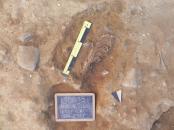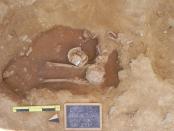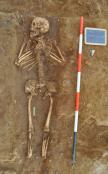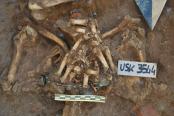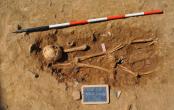CAMPAGNA 2015 |
1° SETTIMANA |
2° SETTIMANA |
3° SETTIMANA |
4° SETTIMANA |
5° SETTIMANA |
6° SETTIMANA |
01 LUGLIO 2015 
Resoconto della giornata di scavo
Area 2000
Nell’area continuano ad emergere numerose altre sepolture. Nella porzione centro meridionale è stato messo in luce e documentato un individuo (Usk 2567) in decubito prono, di cui si conservano esclusivamente l’emitorace sinistro e parzialmente l’omero posto al di sotto dell’addome; la mancanza degli altri distretti anatomici è dovuta alla presenza dei tagli precedentemente indagati che lo intercettano sia a est, sia ad ovest che a nord. Nella porzione più occidentale sono stati documentati e rimossi due scheletri parziali: Usk 2569, orientato Est Ovest, conserva la tibia sinistra ed il calcagno; questo ed altri tagli sepolcrali intercettano Usk 2538, orientato Nord Sud, deposto in posizione primaria con riduzione (US 2539) collocata al di sopra dei piedi in connessione. Le ossa ridotte fanno riferimento ad almeno un individuo, in quanto è stato riconosciuto un cranio, afferente a un individuo adulto di sesso femminile, e alcuni frammenti di bacino. Al di sotto è stato messo in luce lo scheletro in connessione di cui si preservano esclusivamente i piedi e le tibie; la decomposizione è avvenuta in spazio pieno. Per quanto riguarda la metà più orientale dell’allargamento è stato appurato che due dei tagli individuati ieri fanno riferimento ad un unico taglio allungato ed irregolare, orientato Nord Sud, all’interno del quale è stato messo in luce e rimosso Usk 2570. Quest’ultimo è stato disturbato a livello del bacino e le osservazioni tafonomiche effettuate fanno capire che la decomposizione è avvenuta in spazio pieno; l’arto inferiore sinistro risulta esteso mentre il destro leggermente flesso, ad indicare forse una certa fretta al momento della deposizione del corpo. E’ inoltre iniziata la pulizia della porzione più orientale che proseguirà nei prossimi giorni.
Today we filled out all documentation for three circular cuts and fills located at the eastern part of the western expansion, labeled as the following associated cuts and fills: US -2554 and 2555, US -2560 and 2561, and US -2558 and 2559. After further exploration, two cuts previously thought to be isolated, US -2553 and -2557, were found to be connected with both articulated feet, left tibia, left pelvis, and both femurs. This skeleton was labeled USk 2570, for which points and pictures were taken before it was removed and appropriately bagged. While photos were taken of the above stratigraphy, USk 2567 was excavated, exposing a series of left prone ribs, which are articulated with each other but associated with no other exposed bones. The proper documentation was filled for the partial skeleton, the cut, and the fill. When everything was properly exposed, GIS points were taken for the first three cuts and the ribs, USk 2567. These points allow us to see where the ribs laid in the space of our site.
On the western portion of the western expansion, a reduction area of one female crania and a number of other unassociated bones were found and labeled USk 2539. The reduction area was located on top of two articulated feet and tibia along with an associated patella. The bones of the reduction area were removed to expose the articulated lower legs underneath. Just east of the reduction area, at the end of the day, was a crania, mandible, vertebrae, and what seems to be a scapula, left to be further exposed tomorrow. While this was being exposed, cleaning was done along the wall of the southernmost part of the western expansion as well and the area was sprayed with water in an effort to expose additional grave cuts. About three possible cuts were exposed and left to be excavated tomorrow.
Area 3000
La pulizia accurata della porzione settentrionale del Settore B ha permesso la messa in evidenza di alcuni tagli di forma ellittica, probabilmente fosse sepolcrali con diverso orientamento, che si intercettano a vicenda. A sud-ovest continua lo scavo dell’individuo adulto USK 3549, probabilmente di sesso femminile, orientato W-E e deposto in decubito dorsale all’interno di US – 3547. Nella porzione centro-meridionale è stata terminata la documentazione e la rimozione dell’inumato USK 3544, orientato S-N e deposto supino all’interno di una cassa lignea, ormai decomposta; lo scavo dettagliato delle mani, entrambe giunte sul torace in atteggiamento di preghiera, ha evidenziato la presenza di un rosario costituito da fermagli in lega di rame e culminante con una medaglietta devozionale di forma circolare. Nel corso della giornata di domani si procederà con la messa in luce completa dello scheletro USK 3549 e con l’apertura di nuove fosse sepolcrali.
Today in Area 3000, we began to remove skeleton 3544. We have completely removed the lower limbs, upper limbs, pelvis and ribs. We also removed the phalanges, metacarpals and carpals of both hands, which were covering a rosary. We collected the fragmented chain and pendant of the rosary. We will finish excavation tomorrow. On skeleton 3548, we continued excavation and cleaning in order to take a photograph of it. We also removed all of the scattered bones, including a full skull. We also cleaned a new area to prepare for excavation tomorrow.
Area 5000
Nella giornata di oggi sono state indagate due tagli dalla forma circolare posti nella porzione Nord occidentale dell'area. Queste due buche sono però riferibili a periodi molto recenti, subito antecedenti la messa in opera dell'asfalto. E' cominciata quindi la rimozione dello strato US 5172, che si estende su tutta la fascia occidentale dell'area e che sta restituendo frammenti ceramici medievali e una moneta dello stesso periodo. QUest'ultima dovrà essere pulita e restaurata prima che ci possa fornire informazioni più precise relative alla sua provenienza e alla sua datazione.
Today in Area 5000 we began by further examining the stains present on the north-western side. Upon cleaning, these stains appeared to be holes, and thus were photographed. After this we began to excavate said holes; we established one to not be a hole, while the second supported our initial thoughts. In addition to clearing the holes, the large pit at the south-western most corner, henceforth the mortar pit, was cleaned so excavation of this area could begin. In the afternoon, we began to take the western side down a layer. In doing so, we unearthed pottery sherds, a nail, a coin, a needle or a broach pin, and a number of glass pieces, both green and clear. The nail and the coin were found in situ, and thus their location was marked for GIS points to be taken tomorrow. Similar actions occurred in the mortar pit, where we attempted to delineate the layers in the depressed area. When doing this, a fire pit was found just outside the mortar pit, and thus the area was expanded in an attempt to determine the perimeters of the fire pit. When doing this, an animal molar and pottery sherds were found but not in situ. The rest of the afternoon was spent lifting up the remaining mortar to observe the layers underneath.
Area 6000
E' terminata oggi la messa in luce della trincea US -6007, esponendo nuove situazioni stratigrafiche intercettate all'epoca della realizzazione della stessa. Sono così state esposte UUSS 6009 e -6010, UUSS 6011 e -6012 e le UUSS 6013 e -6014; tre tagli con rispettivi riempimenti intercettati dalla posa in opera di US -6007 quindi probabilmente relativi a fasi ben anteriori al XX secolo. E' stata inoltre terminata la messa in luce della sepoltura USk 6015, l'individuo orientato Ovest-Est e parzialmente intercettato dallo scavo della trincea. Contestualmente è stata individuata US 6008, deposito argilloso con forte quantità di calce nella matrice, ipotizzato come fase costruttiva antecedente non solo ad US -6007 ma anche alle strutture della chiesa medievale. Ulteriori indagini permetteranno di confermare o meno tale ipotesi.
First, we began by entirely cleaning and finishing up the main removal of the fill of the trench. After this was completed, we were able to take photographs of specific charateristics in our site (i.e. a burial part of the medieval cemetary and a circular rock formation that is most likely the previous entrance to the basillica). In addition, area 6000 was able to calculate distance, vertical length, and horizon measurements from the total station at the datum using GIS (geographic information systems). This means we were able to describe our particular site in "attributes" and "locations". Following this, we created more area context sheets for areas 6009, 6011, and 6013-describing the physical characteristics of our area. At the end of the day, we started to excavate the fill of area 6013, by removing the filled material and uncovering details of the site and its contents for further excavation. Tomorrow, we plan on continuing the excavation of each area, as well as moving along to uncovering area 6003.







